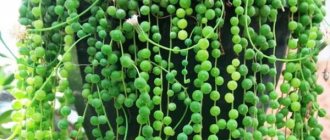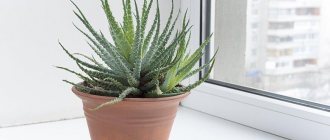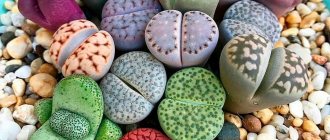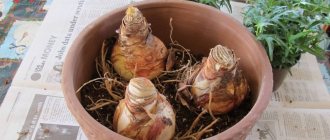- October 29, 2018
- Houseplants
- Natalia Miroshnikova
Croton, or, as it is also called, codiaum, is a perennial shrub of the Euphorbiaceae family. It is valued by gardeners for its unpretentious character and attractive appearance, which is given to it by large, variegated leaves. A description and photo of a croton flower, how to care for and propagate the plant - you will find this and much more in our material.
Description
Croton (codium) is a perennial, decorative deciduous shrub of the Euphorbiaceae family. In its natural environment it can be found on the islands of the Pacific Ocean. And also in Northern Australia and Southeast Asia. The genus of crotons, according to various sources, contains from 17 to 1200 species, but only the variegated variety and its hybrids are grown at home.
Croton flower is a low shrub with large, leathery leaves. Depending on the variety, the plates are oblong-lanceolate, asymmetrical, or broadly ovoid in shape. Their tips can be pointed or blunt.
Young croton leaves are colored in light yellowish-green shades. But over time, they acquire a bright color and can be either dark green or red-burgundy. Moreover, regardless of the variety, there are bright veins or spots on the leaves.
Croton flowers have no aesthetic value. After all, small, inconspicuous buds, painted in cream shades, do not add attractiveness to the plant. In addition, they draw juices from the culture. Therefore, it is recommended to cut them out immediately, of course, if you are not going to propagate the plant by seed.
It is worth considering that croton is a poisonous flower. Its milky sap causes nausea, vomiting, stomach upset and contact dermatitis. Therefore, you need to wear gloves when caring for the plant. In addition, it is important to keep the flower pot out of the reach of children and pets.
Pruning as a way to form a bush
One of the problems when caring for croton is pruning, which is neglected by some gardeners due to the toxicity of the milky sap. Pruning has three functions - the formation of the aesthetic appearance of the bush, the prevention of depletion of the plant due to lack of nutrition to all shoots, and the implementation of hygiene procedures (dry and damaged branches are cut off).
Pruning rules
The toxicity of the plant should not serve as an obstacle when forming the contour of the plant - work should be carried out with gloves, and the juice itself helps to tighten the cuts as quickly as possible.
The procedure should be periodic - when the required height is reached, all stems are pinched or cut off at the end, which leads to the formation of dense lateral shoots. The photo clearly demonstrates the result of cropping.
To create a decorative bush, two methods are used: on young crotons - pinching, on adults - cutting.
After each stage, the bush can be sprayed with stimulants and placed in a mini greenhouse.
During the pruning process, inflorescences and flower buds are removed. With their modest appearance, the flowers do not decorate the bush, but a lot of effort is spent on their formation, which threatens the health of the foliage.
The pruning and formation process has its own characteristics depending on the variety. To increase the splendor of the bush of the not very strongly branched croton Peter, it is possible to plant several plants in a flowerpot. When creating a mix composition, each plant is formed separately, taking into account the needs of its neighbors.
Trimming scheme
Crown formation in young plants should begin in early spring, before the start of the active growing season.
When the croton reaches a height of 15 cm, the first pinching of the upper growth points occurs. Next, all shoots are cut every time their length is 20 cm. This scheme awakens the lateral buds and promotes active branching.
The bush formation scheme includes regular rotation of the plant relative to light sources to prevent one-sidedness of the crown.
In adult plants, the cut points are treated with charcoal powder. Cut shoots are used for cuttings.
Home care
Croton (codium) is an unpretentious plant. But in order to achieve decorativeness and rapid growth of a flower, you will need to create comfortable conditions for it. The following agrotechnical measures will help with this:
- frequent but moderate watering;
- regular feeding;
- periodic transplantation;
- pruning;
- prevention of diseases and pests.
In addition, it is important to maintain optimal temperature and humidity in the room where croton is grown. How to care for the plant is described in detail below.
Location
Croton is a light-loving plant, and the variegated color of its leaves largely depends on the lighting. But prolonged exposure to direct rays is contraindicated for the flower. Therefore, when providing proper care for Croton at home, focus on the weather and time of year.
In spring and autumn, an eastern or western window sill will be the ideal place for a flower. In summer, move the pot to the northern part or move it deeper into the room. In winter, on the contrary, place the flower on a southern windowsill or illuminate it with a phytolamp.
Croton needs fresh air. At any time of the year, do not forget to ventilate the room, but protect the flower from drafts - it absolutely cannot stand it. Therefore, during ventilation, take your pet to another room. In summer you can keep the plant on the balcony. But choose a place with diffused light for the flower.
Watering
Frequent but moderate watering is the basic rule of home care. Croton, the photo of which is given in the material, loves moist, but not wet soil. And stagnation of moisture at the roots leads to rotting and even death of the flower. Therefore, take watering seriously.
Make sure that the soil does not dry out to a depth of more than 2 cm, and always drain excess moisture from the pan. On average, you need to water a flower every other day in summer, and in winter it is enough to moisten the soil once a week. In general, be guided by the conditions in your apartment. For watering, use soft, filtered water at room temperature, standing for at least a day.
Air humidity
In its natural environment, croton lives in tropical rainforests, so for normal growth and development of the flower it is important to create similar conditions. A special device – an air humidifier – will help with this. If you do not have such a device, then place containers filled with water next to the pot. In addition, in winter, keep the plant away from central heating radiators and other heat sources.
Regularly spray the codiaum foliage with warm water from a spray bottle and wipe them from dust with a damp sponge. In summer, carry out this procedure 2-3 times a week, in winter – 2 times a month. During the hot season, give your pet a warm shower. But make sure that water does not get on the soil. To do this, wrap the pot in polyethylene.
Basic rules of care
One of the disadvantages of croton is its increased demands on growing conditions. The plant is very capricious - it can get sick only because its leaves are dusty. When growing it, it is necessary to carefully monitor the microclimate of the room, prevent movement from place to place, and protect it from cooling, drafts and drying out of the soil. A mandatory element is the formation of the crown contour. Decorative foliage and good health are preserved with increased care and careful adherence to all maintenance regimes.
Location and lighting
Croton grows well on eastern and western windows - here optimal proportions between brightness and amount of sunlight are ensured. Croton Mammy responds positively to plenty of evening sunlight. Plants on the north side require additional lighting with fluorescent lamps. On southern windowsills during summer afternoons there is a danger of leaf blades being burned by direct rays of the sun, so slight shading is required.
Sufficient lighting is the key to the well-being of the bush and the decorative appearance of the leaves - the more bright but diffused light, the more colorful the pattern and richer the colors. With a lack of lighting, the rich shades fade, the leaves turn green, losing their variegated color. Low light has the most negative effect on the Petra variety, which requires significant illumination even during the winter rest period.
When using artificial lighting, LED lamps with a warm emission spectrum should be used (conventional incandescent lamps cause burns to leaf plates). Preferably narrowly focused light sources that are located at a sufficient distance from the plants.
Temperature
Heat-loving croton is conservative and requires maintaining temperature indicators at a certain level, without sudden fluctuations and changes.
The ideal summer temperature is +20 - 25°C. When the temperature rises above +27°C, the plant looks depressed; additional spraying is required to increase air humidity.
Temperatures in the winter months should not fall below 17°C (optimally +18 - 20°C). To prevent cooling or sudden changes in temperature, the pot with the plant must be kept away from window glass and heating appliances.
Due to fear of drafts, the flower should not be placed near an open window. For the same reason, in summer it does not need to be taken out onto the balcony or into the garden. The plant must be in one place with a constant microclimate.
Air humidity
The main requirement is high air humidity (ideally 70 - 80%) throughout the year. To create tropical conditions in an ordinary apartment, you can use various methods:
- Use decorative fountains, air humidifiers or water vessels;
- Apply the “double bottom” principle - fill the space between the pot and flowerpot with moss and constantly water it;
- Place the container with the flower in an additional tray with water on large pebbles;
- In the summer heat and in winter when the air is dry due to heating, spray the plant twice a day with a fine spray to prevent burns from the sun's rays hitting the water drops;
- Have a warm shower in the summer months, while covering the pot itself with film to prevent excess moisture;
- Wipe the leaves regularly with a damp sponge.
Irrigation mode
A moisture-loving plant with large leaves evaporates more moisture and therefore requires constant and abundant watering and does not tolerate even slight drying of the soil in the pot. The consequence of insufficient watering can be drying of the tips of the leaves and their subsequent falling off.
During the active growing season (spring - summer), watering should be done daily or every other day, depending on the air temperature . The soil should be moistened, but water should not stagnate in the pot. Excess moisture leads to rotting of the root system. To prevent undesirable consequences, there must be a drainage layer at the bottom of the pot.
In the cold season (autumn - winter), watering should be reduced to 2 - 3 times a week. There is a principle: the lower the temperature, the less watering.
Water for irrigation should be warm - croton is afraid of cold water and can shed its leaves. Chlorinated water must be defended.
Suitable soil
Croton develops well in loose soil, rich in nutrients, with a slightly acidic environment. This may be a ready-made store-bought mixture, but it is good for young bushes. When planting adult plants in it, it is worth adding a little leaf soil - this will increase the density and ensure better moisture retention.
The soil substrate can be prepared independently by mixing turf soil, coarse sand and leaf soil in equal quantities (for adult specimens, the third component is taken in double size).
Disinfecting the mixture will help ensure that the charcoal contains fine particles. The finished substrate can be calcined or shed with potassium permanganate - a safety measure against pests and diseases.
Rules for caring for a store-bought plant
The purchased croton is placed in the place intended for it and left for 2 weeks in a quiet environment for acclimatization. Transferring from a store to an apartment is quite stressful for the plant, so immediate replanting cannot be done. If the bush looks good after the allotted time, and there are no visible reasons for replacing the pot, then there is no need to carry out the procedure. Next, the plant should be cared for according to its usual rules.
Feasibility of flowering
An indicator of proper care of croton is its regular flowering, which is not of interest in terms of decorativeness: the axillary inflorescences consist of small yellowish flowers. But this process requires a lot of energy and nutrients from the plant, so it is necessary to remove flower buds and developing inflorescences.
Need for transplant
For young, actively developing plants, replanting is carried out annually, since the roots quickly fill the volume of the pot and become bare, protruding from the soil. The flower receives insufficient nutrition, its leaves decrease in size and lose their decorative appearance.
Older specimens are replanted as needed, trying not to disturb them more than once every 2 years . The last transplant of croton is considered to be planting it in a pot with a diameter of 25 cm. Next, you should annually remove the top layer of soil and add a new one to the previous volume.
It is imperative to form a drainage layer (at least 3 cm) at the bottom of the pot, which will protect the plant from stagnation of water and root rot. Replanting should be done with extreme care - the slightest damage to the roots can lead to a long rehabilitation period. Therefore, they use the transfer method, when a plant with an earthen lump is moved from pot to pot.
After transplanting and watering, the plant is placed in a place protected from bright rays, where it regains its strength with constant spraying and watering as needed.
Personal hygiene rules
The milky sap of croton is quite poisonous - it can cause severe irritation on the skin or poisoning if accidentally ingested. Therefore, any contact with the plant requires caution: it is better to carry out work with gloves, and then be sure to wash your hands with soap. Keep the plant away from small children and pets.
Top dressing
Without additional feeding, codiaum leaves quickly lose their variegated color, which affects the decorative appearance of the plant. Therefore, regular application of fertilizers is an important rule of care. Feed Croton from late March to early November twice a month with liquid solutions of complex mineral fertilizers. Carry out this activity strictly after watering. Otherwise, fertilizers will burn the roots of the flower.
In winter, the plant enters a dormant period, so at this time the flower does not need feeding. As a last resort, apply fertilizer no more than once a month.
Planting and caring for croton
- Flowering: the plant is classified as an ornamental deciduous plant.
- Lighting: bright sunlight before noon, and then bright diffused light or light partial shade.
- Temperature: in summer 20-22 ˚C, in winter not lower than 16 ˚C.
- Watering: constant but moderate.
- Humidity: high. The plant needs constant spraying and washing of the leaves, as well as regular shower procedures (once or twice a month).
- Feeding: with a solution of complex mineral fertilizer for decorative deciduous plants twice a month from April to November, the rest of the time - once a month.
- Dormant period: winter.
- Transplantation: young plants - 2 times a year, adults - 1 time every two years.
- Reproduction: seeds, leaf and stem cuttings.
- Pests: mealybugs, scale insects, nematodes, spider mites.
- Diseases: sooty fungus, gray rot,
- Properties: the juice of the plant is poisonous.
Read more about growing croton below.
plant (lat. Croton) , also known as codiaeum (lat. Codiaeum) or “Joseph’s cloak ,” belongs to the genus of the Euphorbiaceae family. Nobody knows for sure what the name “croton” means, which gardeners liked more than the scientific “codiaum”, translated from Greek meaning “head”. Maybe this name comes from the name of a city in southern Italy, where Pythagoras once founded his school, or maybe in some dialect this word means “shrub”... The homeland of wild crotons are the islands of the Pacific Ocean and Northern Australia, India, as well as Southeast Asia.
The number of species in the genus varies from 17 to 1200, but in indoor culture croton flowers are represented only by variegated croton and its hybrids. The croton flower is one of the most beautiful decorative foliage indoor plants, which serves as an excellent interior decoration and, as a rule, does not take up too much space. In some countries, the croton houseplant is considered the guardian of the hearth, protecting the house from bad energy.
- Calamus (Acorus) – care, photos, types
Transfer
With proper care at home, croton will grow quickly. And he feels cramped in the old potty. Therefore, it is impossible to do without a transplant. For young plants, carry out this procedure 1-2 times a year. Replant adult specimens no more than once every 3 years.
Start the event in early spring, then the flower will more easily withstand the stress of the procedure. Perform the transplant itself using the transshipment method, being careful not to damage the earthen ball and the roots of the flower.
Please note that in a container that is too large, water will stagnate, and this will lead to rotting of the roots. Therefore, for the plant, choose a shallow pot, the diameter of which is 2 cm larger than the previous one. When your pet takes up a container with a circumference of 25 cm, do not replant it anymore. But at the same time, change the top layer of soil annually to a depth of 2–3 cm.
For replanting, use universal store-bought soil intended for decorative foliage plants. If you want to make the soil yourself, then mix the following components in equal parts:
- peat;
- humus;
- turf soil;
- sand.
Please note that pathogenic microbes and pests can live in such a substrate. Therefore, be sure to disinfect the mixture. To do this, keep it over steam or heat it in the oven. After disinfection, add some charcoal to the substrate. To prevent the plant from suffering from stagnation of moisture at the roots, be sure to add drainage made of brick chips, pebbles or expanded clay to the bottom of the container. Moreover, this layer should make up a quarter of the volume of the pot.
Pruning and crown formation
The side shoots of croton grow more slowly than the central stem. Therefore, it is important to shape the crown of the flower so that the bush grows lush. Perform the first pinching of the plant when the codiaum reaches a height of 15 cm. This will provoke increased growth of side shoots. Repeat pinching when the branches grow 20 cm in length.
In the future, regularly shorten shoots that are too elongated and remove dried leaves, damaged and weak branches. And also cut out flower buds, because they drain the plant’s strength. After the procedure, be sure to sprinkle the cut areas with crushed charcoal.
Propagation by seeds
This propagation method is not popular among plant growers. After all, growing croton from seeds takes a lot of time. In addition, flowers propagated in this way do not retain varietal characteristics.
If you don’t mind experimenting, then start the event in January-February. Please note that croton seeds quickly lose their viability. Therefore, for germination, use fresh grains collected this year. Before planting, be sure to prepare the seed material. To do this, keep the seeds for half an hour in water at a temperature of +60 °C. And then soak them for a day in warm water with the addition of any growth stimulant.
Plant the prepared grains in moistened, universal soil for seedlings to a depth of 0.5-1 cm. Please note that before sowing you need to warm the mixture to +22 °C, and then you should maintain it in this condition. Therefore, you can’t do without bottom heating. After planting, stretch glass or polyethylene over the container or pot and place the improvised greenhouse in a warm place.
Regularly moisten the soil, preventing it from drying out, and use the bottom watering method. That is, place the greenhouse for a while in a basin filled with warm, settled water. And also do not forget to wipe off condensation from the shelter. Maintain the temperature near planting within +22-25 °C. Only under such conditions will croton seeds germinate at home.
How to care for seedlings
The first seedlings will emerge a month after sowing. Once this happens, start hardening off the plants. To do this, remove the cover from the greenhouse first for an hour, then for two and gradually increase the time.
Until the seedlings get stronger, keep them in a lighted place out of direct sunlight. If the weather is cloudy, be sure to illuminate the sprouts with a phytolamp. Do not forget to regularly spray the soil with warm, settled water from a spray bottle.
When the seedlings have 2-3 leaves, carefully pick them into individual containers, being careful not to damage the delicate roots. Select the soil as for adult plants. More information about the substrate is written in the chapter “Transplantation”.
Narrow-leaved varieties of croton
A very spectacular croton, varieties of which are used in the design of not only city apartments, but also spacious country houses and offices. By providing the plant with favorable conditions, you can get a bush more than 1 m high. The variety differs from other crotons in its unique narrow leaves.
Needs diffused light, moderate watering, spraying. In the shade it can shed its leaves, exposing the trunk. In winter, it is not recommended to place croton near heating appliances. Dry air is harmful to it. At temperatures below +18 °C, a houseplant may die.
Croton Mammy
A very bright and unusual variety. Thanks to its colorful foliage, it will never get lost among other indoor plants. The main features of croton:
- bush height more than 1 m;
- leaf blades are narrow, small, wavy or spirally twisted around a central vein;
- variegated color - a combination of dark green, red, yellow, pink shades.
To preserve its decorative appearance, it is recommended to provide the plant with good lighting, while shading it from direct sunlight. Mammy loves moist soil and regular spraying.
Croton Sunny Star
A distinctive feature of the plant is its many side shoots. Due to its tendency to grow all-round, the indoor flower forms a luxurious bush, filling the entire space in the pot. Main features of the variety:
- bush height 0.6-0.8 m;
- the leaf blade is dense, leathery, elongated, rounded at the tips;
- The color depends on the location, as well as the age of the leaves.
Old foliage is dark green with red spots and streaks. The middle one is a combination of rich greens and yellow. Young leaves are light green with splashes of lemon tint. To prevent Sunny Star from losing its decorative effect, it is recommended to place it on western or eastern windows. This way he will receive his dose of sunlight and will not burn.
Croton Zanzibar
A popular variety among gardeners. It looks harmonious both in a small city apartment and in a spacious office space. The main features of a houseplant:
- codiaum height is about 1 m;
- the leaf blade is leathery, dense, narrow, lanceolate, with curves;
- The color is represented by a combination of all shades of green, purple, yellow, and red.
Crotons Zanzibar are one of the easiest and most unpretentious to care for. They should not be placed in the shade or allowed to dry out too much. Otherwise, the plants will shed their leaves, exposing the trunk, losing all decorativeness. They respond well to a warm shower. It is best to spray with boiled water to avoid the appearance of unsightly lime stains on the leaves.
Croton Tamara
One of the most unusual and rare varieties in floriculture. Forms one straight stem with many leaves raised upward. The sizes are average, depending on growing conditions. The main features of a houseplant:
- bush height up to 1 m;
- the leaf blade is dense, leathery, elongated, with a pointed tip, jagged edges;
- the stem and petioles are dark green.
The highlight of croton is its feathery leaves. Most of them are white with a scattering of green dots. But there are also leaves with more voluminous green spots. Like all representatives of the species, Tamara needs diffused light and regular spraying. It is necessary to water as the earthen clod dries. The flower does not tolerate stagnant water.
Propagation by cuttings
This propagation method is quite simple and even a novice gardener can handle it. Moreover, the event can be held at any time of the year, except January - February. During this period, the croton rests. And the planted cuttings will grow roots poorly or, in general, will rot.
For propagation, select woody twigs from the top of the plant. Each cutting must have at least one strong bud and a pair of leaves. It is desirable that the length of the workpieces reach 10–15 cm in length. It is better to root cuttings in water. But before that, wash off the milky juice, dry the branches for 2 hours in a bright, warm place, and carefully tie the leaves into a tube. This way, you will prevent the rapid evaporation of moisture from croton leaves. How to care for cuttings at home:
- Keep the branches in water with a temperature between +25-30 °C. If you want to speed up rooting, add a root formation stimulator to the liquid, for example, “Kornevin” or “Epin”.
- Place the container with cuttings in a bright place where direct rays of the sun do not reach.
- Maintain the room temperature +22-25 °C.
- Add fresh, warm water to the container as it evaporates.
As a rule, rooting of cuttings takes 1–2 months. When the shoots reach 2–3 cm in length, transplant the plants into individual pots. For the first two weeks, keep them in a warm place with indirect light and high humidity. In the future, provide the usual care for croton flowers at home.
Diseases and pests
Croton is a plant with strong immunity, and, as a rule, the flower does not get sick. But in some cases, root rot occurs. This is caused by excessive moisture, especially in the cold season. To save your pet, replant the flower in new soil. At the same time, carefully remove the old earthen lump and cut out all the rotten roots. Treat the cut areas with charcoal.
The poisonous sap of croton repels most pests. But if there are errors in care, the plant’s protective functions weaken and it is attacked by parasites. Codium can be attacked by the following pests:
- Spider mite. This pest lives on the underside of leaves and looks like a small red spider. It can be recognized by the sticky, silvery web that forms on all parts of the flower. To remove the parasite, treat the plant three times with a systemic insecticide such as Actellik or Neoron. Maintain an interval of 7 days between sprayings.
- Shield. This pest can be recognized by dark brown, raised spots covering the leaves and stems of the plant. To destroy the parasite, treat the bush with a soap or tobacco solution with the addition of kerosene. Then spray the plant with an insecticide.
Provide proper care for your croton at home, and the flower will not be afraid of any diseases or pests.
Lobed varieties of crotons
In appearance, the plants are similar to three-lobed varieties of codiaum. The main difference is that the leaf plate is solid, without side blades. It can be of different sizes and colors. There are indoor flowers with pointed and rounded tips. Let's look at the most popular varieties.
Croton Petra
One of the most favorite varieties among gardeners. Thanks to its densely leafy straight trunk, it creates the impression of a luxurious, slender tree. Main features of the plant:
- bush height is about 0.7 m;
- the leaf blade is large, compacted, lobed, oval or pointed in shape;
- The color is dark green with contrasting yellow veins.
Codiaum needs good lighting and spraying. Does not like dry air and drafts. Therefore, it is not recommended to place it near heating devices or in ventilated areas.
Croton Mrs. Eyeston
A very beautiful variety, valued for the color and appearance of the leaves. The shape is a slender tree, the trunk of which is not visible due to the abundance of foliage. Main characteristics of the codiaum:
- plant height is more than 1 m;
- leathery leaves are small, oval, with pointed tips;
- The colors are varied, depending on the age of the leaves and growing conditions.
Young leaves are green with cream spots. As they grow older, yellow, pink, maroon and even black stains appear on the plates. The indoor plant remains decorative provided that the earthen ball and leaves are constantly moistened.
Growing problems
With frequent care mistakes at home, the croton begins to act up. In some cases, flower growers face the following problems:
- The leaves of the flower fall. If the trunk becomes exposed from below, then do not worry, because this is a natural process. If the plant loses its top leaves, it means that you are keeping the flower in a too cool room or the croton is suffering from a draft.
- Leaves change color. This phenomenon indicates that the pet does not have enough light. Move the pot closer to the window or provide additional lighting with a phytolamp. And the croton will restore its variegated color.
- Brown spots appear on the leaves. Such damage causes sunburn. To correct the situation, move the flower to a room with diffused light. As a last resort, hang tulle or gauze over the pot during the midday hours.
- Croton dropped its leaves. A similar phenomenon is caused by a lack of lighting. Irregular watering can also cause leaves to droop. If the soil is too dry, do not flood the plants, but gradually increase the moisture. Otherwise, too much watering will lead to rotting of the roots.
- Codiaum leaves are drying. The main reason for this phenomenon is insufficient air humidity. To correct the situation, spray the flower more often. If brown spots also appear on the drying leaves, it means that you water the flower with cold water or keep the pot on a cool windowsill.
- The plant is not developing well. This is caused by a lack of light or poor soil composition. To correct the situation, move your pet closer to the window, and do not forget to regularly feed the flower.
Possible problems and solutions
Any problems that arise in Croton only appear when there are serious mistakes in care. To eliminate them, it is necessary to thoroughly study the negative signs of damage, analyze the conditions of maintenance and possible violations, and then begin treating the plant, adjusting the methods and care regimens.
Croton leaves dry out and fall off
When the leaves at the bottom of the trunk dry and then fall off, the natural aging process occurs. There is no reason to worry, since all the other leaves are in excellent condition.
If the process begins with dry tips of the leaves and ends with them falling off - this is a sign of low air humidity in the room - the tropical plant is drying out from lack of moisture.
Low temperature when keeping croton indoors is expressed by the drying edges of the leaf blades, as well as the appearance of brown spots - the flower suffers from the cold and soon reacts to this by falling leaves. The same picture occurs when the plant is in a draft.
A long period of insufficient watering leads to massive drying and shedding of leaves. In this case, the roots do not receive enough water and cannot provide moisture to the entire plant.
All these problems can be eliminated by adjusting temperatures, watering and spraying schedules, or removing the flower from a draft.
The leaves have lost their elasticity
The problem arises from excessive soil moisture - frequent and abundant watering, which does not allow the soil to dry out a little. Sometimes there is rotting of the stem, and there is a danger of rotting of the roots. Eliminating the problem is possible by revising the watering schedule and maintaining a dry regime for several days.
Why does croton grow very slowly?
Poor growth or its complete absence may indicate poor lighting in the room - sunlight for a tropical bush is a fundamental link in the life cycle. It is necessary to move the pot to a illuminated area of the window or room.
drooping leaves
The problem arises if the plant itself or its roots are frozen (drafts or temperature changes) - the croton is not able to drink. It is necessary to adjust the watering and move the flower to a warm and quiet place.
Another reason for drooping leaves may be a significant lack of moisture in the pot. When the soil dries out, immediately water the plant with warm water and spray the leaves generously. Frequently bringing a flower to the point of “drooping” is fraught with complete leaf fall and death.
Dull young foliage
Young growth that is not too bright and not decorative is a natural phenomenon for croton. New leaves are dull green or yellowish in color. With age, the color acquires red-brown tones and becomes bright and variegated.
Sudden leaf fall
Sudden and massive leaf fall occurs as a result of watering with cold water. The plant's roots prefer water at room temperature. It is necessary to ensure proper watering and, if necessary, heat the water.
The decorative effect of the leaf plate changes
Directly opposite reasons can lead to this result:
- A small amount of sunlight leads to a change in bright, contrasting color to pale, green tones - croton should be removed from the shade.
- Too bright rays of the summer sun can burn the leaves, brown spots of burns will appear on them - you need to control the lighting and shade the flower during the midday hours.
Fluffy coating on the aerial parts
Watering with hard water with a high salt content leads to the appearance of a white fluffy coating on the leaves and stems - salts are released through the pores. To prevent this phenomenon, you should water the croton with settled water.
Leaf deformity and loss of variegated color
The need to monitor the regime and composition of mineral supplements is due to the influence of certain elements on the beauty of the leaves. A large amount of nitrogen leads to loss of multi-colored colors. Too frequent application of fertilizers leads to the appearance of deformed leaf plates. Lack of nutrition is also the cause of the formation of ugly leaves, but they are small in size. In any case, adjustment of the feeding schedule is required.
The appearance of pests
Various pests can appear on a poisonous plant only when its condition is unfavorable due to poor maintenance.
Dry air, insufficient watering and contamination of leaf blades lead to damage by spider mites, scale insects or hairy lice. Pests suck out nutritious juices, which can lead to the death of the plant. A mite infestation can be identified by thin threads of cobwebs on the stems and leaves, a scale infestation can be identified by white spots and sticky secretions; hairy lice cover the leaves with a whitish coating. Affected croton must be removed from other plants to prevent the spread of parasites.
Elimination of the problem is possible by washing with soap and tobacco solution, wiping the leaves with a sponge with vegetable oil (effective against scale insect larvae) or treating (in advanced cases) with insecticides. At the same time, it is necessary to adjust the conditions for keeping croton.
But it is better to prevent defeat than to eliminate its consequences. Therefore, plants must be regularly inspected for pests.
Croton diseases
They arise as a result of errors in care when growing indoors.
Incorrectly selected soil with low acidity is dangerous for the development of root rot. With it, the leaves look pale, gradually turn yellow and fall off. The roots soften and the plant may die.
With abundant and frequent watering, red-gray spots appear on the leaves. This is a characteristic manifestation of a fungal disease - anthracnose. Over time, it affects all above-ground parts, disrupts the supply of nutrients and threatens the death of the plant.
In case of any disease, the plant is separated from the rest, care regimens are adjusted and treated with fungicides.
Caring for croton requires careful attention to it and compliance with all growing rules. The result is a healthy, bright and decorative plant in the apartment.
Reviews
Croton is popular among users. According to reviews, this plant is unpretentious and even a novice gardener can care for it. In addition, codiaum has a thick and bright crown that complements any interior. And with proper care at home, croton practically does not get sick.
In general, the attractive croton will decorate your collection of home flowers, because it is decorative and grows quickly. Moreover, growing the plant is not that difficult. The main thing is to follow the recommendations and provide proper care for Croton at home.
Common types of indoor crotons, their photos and names
As already mentioned, all varieties of the plant are bred on the basis of variegated croton. The most beautiful of them and the most popular in indoor floriculture include the following varieties:
- Codium Petra is an erect, highly branched plant with dense, leathery, large leaves alternately placed on the shoots. The foliage of Croton Petra can be oval, pointed or lobed, with a bright green base color, yellow edging, veins and specks of the same shade;
- Excelent is attractive for its unusual foliage, very reminiscent of oak. It has a bright yellow-green color on the upper surface and yellow-red on the lower surface;
- Codium mix is several croton plants in one pot, which do not indicate the variety. Therefore, if necessary, to establish the exact name of the purchased species, it may be necessary to contact a specialist in this field;
- Codiaum Mrs. Iceton has broad, rounded leaves of medium length. Their green surface is decorated with a cream-colored pattern; over time, red, pink and yellow spots appear on it;
- The foliage of Sunny Star has a lanceolate, pointed shape. It is green at the base and top, and yellow in the middle. The newly emerging leaves of this codiaum are colored soft green with yellowish specks and a central vein;
- Codiaum Mammi is a very picturesque plant with narrow, small, wavy foliage and a branching, erect stem. The color of the foliage on one tree can be green, or reddish with pink specks, or light yellow with reddish veins;
- Zanzibar is an unusual croton variety that has thin, long leaves in rich green, red, burgundy and orange colors.











